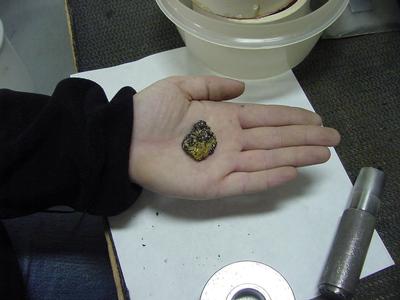
|
|
24 September, 2001
September 24, 2001
A Gas of an Idea
There is a scientist on our expedition who is interested in a gassy matter--
helium in rocks. Dr. David Graham, a scientist from Oregon State
University, is collecting rocks during our expedition in order to do a
helium analysis on them when we return home. Not all rocks that come up
from the ocean floor will be used in his work, but Dave is collecting
samples of young basalt rocks with a fresh, glassy surface for his study.
Imagine the interior of the Earth. At its surface you have the solid crust,
but at some places in the crust (such as mid-ocean ridge boundaries), you
find that magma escapes, cools, and forms new rocks. When this process
occurs, gasses from inside the Earth are trapped in the magma and therefore
come to the surface in these newly formed rocks. This gas can provide much
information for scientists.
Upon returning to the lab, Dave Graham will extract gas trapped in bubbles
in the glassy rocks that he has collected. In rocks from this part of the
planet, mid ocean ridges, the most common gas found is carbon dioxide. But
for every 10,000 parts of carbon dioxide in the rock, there will be just 1
part helium-the gas that Dave Graham is interested in. This is a very small
amount of gas to work with if you consider that most of the rocks being
analyzed are not much bigger than a marble!
Why would anyone want to study such a tiny amount of helium gas in a small,
glassy rock? Well a small amount of helium can tell a large story. Upon
analysis, the helium will provide valuable information about a place that we
can't visit-the Earth's interior. The helium in rocks tells us how gases
move inside of the Earth. It tells us that some gases have been inside of
the Earth since it's first days and is being released through rocks for the
first time ever. It also tells us how deep the magma came from that formed
the rock.
I am learning much about the amazing information that rocks can store. I am
truly a student of geology here, and I have constantly been challenged to
expand the horizons of my thinking over the past 2 months. I never imagined
that such common objects as rocks could hold so many answers to mysteries of
our wonderful planet.

This piece of glassy rock will be crushed in a vacuum chamber. The helium gas that escapes from the broken bubbles inside of it will be trapped, collected, and analyzed.
Contact the TEA in the field at
.
If you cannot connect through your browser, copy the
TEA's e-mail address in the "To:" line of
your favorite e-mail package.
|
